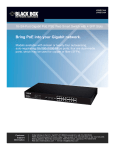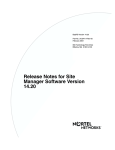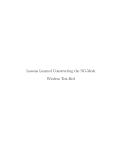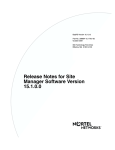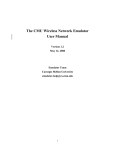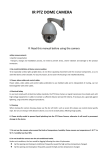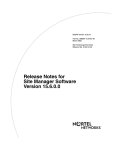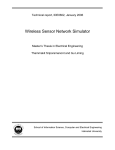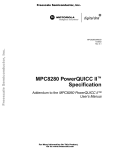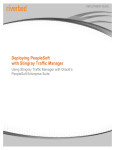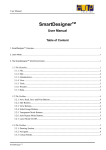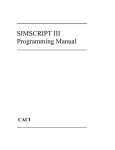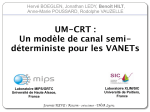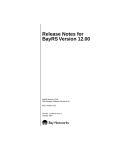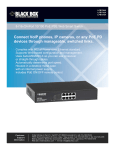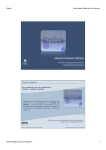Download Qualnet Tutorial - SCALABLE Network Technologies
Transcript
Qualnet Tutorial Scalable Network Technologies with contributions by Chaiporn Jaikaeo and Chien-Chung Shen University of Delaware © Scalable Network Technologies Contact: [email protected] 1 Outline QualNet Overview: slides 3-10 Installation: slides 11-16 Simulation Architecture: slides 17-20 Wireless Experiment Design (both command line and GUI): slides 21-46 Animator Execution (demo): slides 47-52 Analyzer: slides 53-59 Resources: slide 60 © Scalable Network Technologies Contact: [email protected] 2 Advantages of QualNet Rapid prototyping of protocols Comparative performance evaluation of alternative protocols at each layer Built-in measurements on each layer Modular, layered stack design Standard API for composition of protocols across different layers Scalability via support for parallel execution GUI Tools for system/protocol modeling © Scalable Network Technologies Contact: [email protected] 3 Genesis: GloMoSim, DARPA funded effort at UCLA (‘97 – ‘00) for efficient simulation of large heterogeneous networks How does the network perform as it is scaled to 10000+ heterogeneous devices? UAV Network Heterogeneous devices & networks Mobile Ad Hoc Networks Satellite Comm Which routing algorithm? DARPA Objective: Large Heterogeneous Network Simulation © Scalable Network Technologies Contact: [email protected] 4 QualNet Commercial derivative of GloMoSim Substantially expanded MANET models: AODV, DSR, OLSR, 802.11 DCF, 802.11 PCF, 802.11a, directional antennas, … Rapid GUI-based model design, animation & analysis High-fidelity commercial protocol & device models Analysis: Comparative performance evaluation of alternative protocols at each layer Built-in measurements on each layer Modular, layered stack design Scalability via support for parallel execution © Scalable Network Technologies Contact: [email protected] 5 QualNet Versatility GloMoSim was designed for MANET QualNet supports a wider range of networks and analysis MANET QoS Wired Networks Satellite Cellular This presentation focuses on QualNet’s MANET features © Scalable Network Technologies Contact: [email protected] 6 QualNet Model Library MANET QoS OSPF, BGP, router configuration, IGRP, EIGRP, HSRP, import of LAN configuration Satellite WFQ, WRR, SCFQ, CBQ, QoSPF, diffserv, RED, RIO, WRED, RSVP-TE Wired Networks 802.11a, 802.11b, CSMA, MACA, AODV, DSR, LAR1, STAR, ODMRP, ZRP, FSR, OLSR, directional antenna Geo-stationary Cellular GSM © Scalable Network Technologies Contact: [email protected] 7 QualNet Layer Model Data Plane Uses an architecture that is similar to one used in physical networks with well-defined APIs between neighboring layers Provides capability for network emulation by supporting direct code migration between the model and operational networks. Protocols interface with a welldefined API defining interactions between layers immediately above and below its own The unit defining the interaction is the Message, which is generally either a Packet or a Timer © Scalable Network Technologies CBR, ftp, telnet, … TCP, UDP, RSVP IP Transport IP OSPF, AODV, … Packet Store/Forward IEEE 802.11, 802.3, … Radio, bus, point-point... wired Application Network Link Layer MAC Layer Physical Free space, TIREM Contact: [email protected] 8 QualNet Developer Toolkit Animator: Graphical experiment set up & animation tool Designer: Graphical, finite state machine-based custom protocol design tool Analyzer: Statistical graphing tool for built-in and custom statistics collection Tracer: Packet level tracing & visualization tool. © Scalable Network Technologies Contact: [email protected] 9 QualNet Directory Structure /addons /application /bin /data /gui /include /mac /main /mobility /network /phy /tcplib /transport /verification optional packages application layer protocols and traffic generators executable and configuration or input/output files storage for sample files, e.g. modulation and terrain the Graphical User Interface (GUI) common include files code for the mac layer protocols the basic design framework/Makefiles the code for mobility models code for the network layer and routing protocols wireless physical and propagation models trace based TCP applications (FTP, TELNET, HTTP) transport layer protocols (TCP/UDP) Sample files and outputs © Scalable Network Technologies Contact: [email protected] 10 Installation Prerequisites C Compiler Visual C++ 6.0 w/ SP5 on Windows Must be configured to run from the command line. gcc on Unix Java version 1.3. A QualNet license. © Scalable Network Technologies Contact: [email protected] 11 Program Environment Define QUALNET_HOME and add GUI and path On Unix (assuming csh or tcsh), add to .cshrc setenv QUALNET_HOME ~/qualnet/3.6 set path=($path ~/qualnet/3.6/gui/bin) On Windows Right-click My Computer, choose Properties Choose Advanced → Environment Variables Add QUALNET_HOME with value C:\qualnet\3.6 Edit Path: add C:\qualnet\3.6\gui\bin Click OK. © Scalable Network Technologies Contact: [email protected] 12 Compilation On Windows cd %QUALNET_HOME%\main copy Makefile-windowsnt Makefile nmake On unix cd $QUALNET_HOME/main make -f Makefile-<osname>-<compiler> (e.g. on Linux, make -f Makefile-linux-gcc-2.95) © Scalable Network Technologies Contact: [email protected] 13 Trial Run Run the default experiment cd C:\qualnet\3.6\bin qualnet default.config Examine the output more default.stat © Scalable Network Technologies Contact: [email protected] 14 Animator Start Animator by doing one of the following: From a Command Prompt, type RunQualnet Or … Click QualNet icon on desktop Press Setup QualNet Parameters Go to Wireless Settings tab © Scalable Network Technologies Contact: [email protected] 15 Animator Layout Zoom Control Runtime Control Toolbar Current Simulation Time Manual Configuration Toolbar Animation Settings Toolbar © Scalable Network Technologies Canvas Contact: [email protected] 16 Simulation Study Life Cycle (Re)define (for Network Models) Experiment(s) Application (Traffic Generation) Mobility Specification Execute Model Collect statistics Device Model(s) Environment model Objective: Accurate real-time analysis to enable dynamic management & reconfiguration of comm networks Analyze Results © Scalable Network Technologies Contact: [email protected] 17 Simulation Experiment Life Cycle Startup Execution Read Input Files Initialize Wireless Environment Create/Initialize Nodes Check for External Inputs (via HLA, etc.) Execute Events Shut down Finalize Nodes Produce Output Files © Scalable Network Technologies Contact: [email protected] 18 Node Life Cycle Initialization Event Handling Bottom up layer initialization Read Input Files Creation Scheduling Handling Finalization Printing Statistics © Scalable Network Technologies Contact: [email protected] 19 Packet Life Cycle Application Application MESSAGE_Alloc(…) MESSAGE_Free(…) MESSAGE_PacketAlloc(…) MESSAGE_Send(…) Transport Transport MESSAGE_AddHeader(…) MESSAGE_RemoveHeader(…) MESSAGE_Send(…) MESSAGE_Send(…) Routing IP IP MESSAGE_AddHeader(…) MESSAGE_RemoveHeader(…) MESSAGE_Send(…) MESSAGE_Send(…) MAC MAC MESSAGE_AddHeader(…) MESSAGE_RemoveHeader(…) MESSAGE_Send(…) MESSAGE_Send(…) Physical © Scalable Network Technologies Physical Contact: [email protected] 20 Experiment Design & Analysis Setting Global Variables Node placement & mobility Specifying topology and configuring networks Adding Traffic Simulation time & seed, coordinate system, terrain Layer/Protocol related parameters: Channel/Radio Physical Layer MAC Layer Network Layer Application setup Running & Analyzing © Scalable Network Technologies Contact: [email protected] 21 Configuration Files Line entry format: [Qualifier] <PARAMETER>[Index] <VALUE> Qualifier (optional) specifies a range of nodes and has precedence over the general one Similarly, the optional Index specifies an array of parameters, such as priority queues. E.g. MOBILITY MOBILITY NONE NONE [5 [5 thru thru 10] 10] MOBILITY MOBILITY RANDOM-WAYPOINT RANDOM-WAYPOINT Notes: Some settings require additional parameters, e.g. MOBILITY Lines starting with # are treated as comments © Scalable Network Technologies Contact: [email protected] 22 Qualifiers and Indices Global Qualifier MOBILITY NONE Subnet Qualifier [N8-2.0] MAC-PROTOCOL MACA Node Qualifier [5 thru 15] MOBILITY NONE Index for an array of 3 priority queues QUEUE-WEIGHT[0] 0.5 QUEUE-WEIGHT[1] 0.3 QUEUE-WEIGHT[2] 0.2 © Scalable Network Technologies Contact: [email protected] 23 Other Configuration Files Node placement: NODE-PLACEMENT-FILE Æ See details in bin/default.nodes Mobility trace: MOBILITY-TRACE-FILE Æ See details in bin/default.mobility Static routing: STATIC-ROUTE-FILE Æ See details in bin/default.routes-static Link/node faults: FAULT-CONFIG-FILE Æ See details in bin/default.fault Multicast membership: MULTICAST-GROUP-FILE Æ See details in bin/default.member © Scalable Network Technologies Contact: [email protected] 24 Important Global Variables EXPERIMENT-NAME: Name of the output statistic file e.g. EXPERIMENT-NAME default Resulting statistics are written in default.stat SIMULATION-TIME: The length of time to simulate. e.g. SIMULATION-TIME 15M (Available time units: NS, US, MS, S, M, H, D; default is in seconds) SEED: The random seed used to derive all other seeds used in the simulation. e.g. SEED 1 © Scalable Network Technologies Contact: [email protected] 25 Coordinates and Terrain Dimensions COORDINATE-SYSTEM: LATLONALT or CARTESIAN e.g., COORDINATE-SYSTEM TERRAIN-DIMENSIONS: The size of the rectangular area to simulate (in meters) for Cartesian coordinate. e.g., TERRAIN-DIMENSIONS CARTESIAN (1000, 1000) Terrain corners are required by LATLONALT system e.g., TERRAIN-SOUTH-WEST-CORNER (30.00, 40.00) TERRAIN-NORTH-EAST-CORNER (30.01, 40.01) Irregular terrain TERRAIN-DATA-TYPE DEM DEM-FILENAME[0] ../data/terrain/los_angeles-w DEM-FIlENAME[1] ../data/terrain/los_angeles-e # Tie nodes to the ground level MOBILITY-GROUND-NODE YES © Scalable Network Technologies Contact: [email protected] 26 Node Placement NODE-PLACEMENT: GRID, RANDOM, UNIFORM, FILE GRID RANDOM UNIFORM GRID-UNIT Use FILE to specify node positions in a file NODE-PLACEMENT FILE NODE-PLACEMENT-FILE ./default.nodes Format: nodeId 0 (x, y, z) [azimuth elevation] © Scalable Network Technologies Contact: [email protected] 27 Node Placement In GUI Manual Choose Device type and place Automatic Experiment->Automatic Node Placement Choices of Uniform, Random or Grid © Scalable Network Technologies Contact: [email protected] 28 Mobility Model NONE, TRACE RANDOM-WAYPOINT e.g. MOBILITY RANDOM-WAYPOINT MOBILITY-WP-PAUSE 30S MOBILITY-WP-MIN-SPEED 0 MOBILITY-WP-MAX-SPEED 10 (min,max) (min,max) pause MOBILITY-POSITION-GRANULARITY: distance in meters at which a node’s location is updated ) small values potentially slow down the simulation Location updates when granularity = 5 5m 1m Location updates when granularity = 1 © Scalable Network Technologies Contact: [email protected] 29 Setting Up A Wireless Scenario (1) Scenario Description Two small subnets communicating on different frequencies, 2.4GHz and 2.5GHz Mostly default settings: 802.11b, AODV, Two-Ray… 5 nodes in the scenario Two subnets each within 300m of at least one other node 3 in each subnet, one in both One with Listening/Listenable Mask = 01, the other set to 10. One CBR application between two distant nodes © Scalable Network Technologies Contact: [email protected] 30 Specifying Topology SUBNET Parameter SUBNET <subnet> { comma-delimited list of nodes } Ex. SUBNET N8-1.0 { 1, 3, 7 thru 9 } NodeIds 1, 3, 7, 8, and 9 have network interfaces with address 0.0.1.1 through 0.0.1.5 Node ID Interface Address 1 0.0.1.1 3 0.0.1.2 7 0.0.1.3 8 0.0.1.4 9 0.0.1.5 Basic form: SUBNET N16-0 { 1 thru n } n is the number of nodes IP address and Node ID are identical Æ Node 5 has IP address 0.0.0.5 © Scalable Network Technologies Contact: [email protected] 31 Subnet Shorthand Format: N<# host bits>-<address with front end 0’s omitted> Ex. N8-1.0 The subnet address is 0.0.1.0 Host IP addresses are 8 bits This allows for 28-2 (254) hosts in this subnet with IP addresses numbered from 0.0.1.1 through 0.0.1.254 The broadcast address for this subnet is 0.0.1.255 The subnet mask is 255.255.255.0 N8-0.0.1.0 is an equivalent representation © Scalable Network Technologies Contact: [email protected] 32 Wireless Scenario Layout in Animator © Scalable Network Technologies Contact: [email protected] 33 Command Line Layout SUBNET N3-1.0 {1, 2, 3} [N3-1.0] CHANNEL-LISTENABLE-MASK 10 [N3-1.0] CHANNEL-LISTENING-MASK 10 SUBNET N3-2.0 {3 thru 5} [N3-2.0] CHANNEL-LISTENABLE-MASK 01 [N3-2.0] CHANNEL-LISTENING-MASK 01 © Scalable Network Technologies Contact: [email protected] 34 Wireless Settings in Animator Open Global Parameters © Scalable Network Technologies Contact: [email protected] 35 Channel Properties Channel Frequencies PROPAGATION-CHANNEL-FREQUENCY[0] 2.4e9 PROPAGATION-CHANNEL-FREQUENCY[1] 2.5e9 For each frequency you can set Statistical Propagation model Pathloss model Free space or two ray or ITM Fading model Rayleigh Ricean © Scalable Network Technologies Contact: [email protected] 36 Propagation Model PROPAGATION-LIMIT: received signals with power below this limit (in dBm) will not be processed. e.g. PROPAGATION-LIMIT -111.0 PROPAGATION-PATHLOSS-MODEL: specifies path-loss model FREE-SPACE Æ Empty space, no ground (r2 loss) TWO-RAY Æ Flat ground (r4 loss for far sight) Considers a ray bounced back from the ground d hTX d’ hRX ground ITM Æ Irregular terrain (terrain database required) © Scalable Network Technologies Contact: [email protected] 37 Fading Model Applied to only narrowband channels (flat fading) Specified by PROPAGATION-FADING-MODEL Available models NONE – No fading RAYLEIGH – Highly mobile, no line of sight RICEAN – requires an additional parameter RICEAN-K-FACTOR K = 0 : no line of sight (similar to RAYLEIGH) K = ∞ : strong line of sight e.g. PROPAGATION-FADING-MODEL RAYLEIGH © Scalable Network Technologies Contact: [email protected] 38 Physical Layer (Radio) Model Noise modeling Thermal noise Interference PHY-NOISE-FACTOR (default 10) PHY-TEMPERATURE (in K; default 290) PHY-RX-MODEL (SNR-THRESHOLD-BASED | BER-BASED) Parameters specific to 802.11b PHY802.11b-DATA-RATE (in bps) PHY802.11b-TX-POWER (in dBm) PHY802.11b-RX-SENSITIVITY (in dBm) PHY802.11b-RX-THRESHOLD (in dBm) © Scalable Network Technologies Rx threshold A Rx sensitivity C B Contact: [email protected] 39 Antenna Models Omnidirectional Switched beam (same shape, different angle) ANTENNA-MODEL SWITCHED-BEAM ANTENNA-AZIMUTH-PATTERN-FILE default.antenna-azimuth Steerable (different shape, different angle) ANTENNA-MODEL STEERABLE ANTENNA-AZIMUTH-PATTERN-FILE steerable.antenna-azimuth © Scalable Network Technologies φ Pattern 3 Pattern 0 Pattern 2 Pattern 1 φ Pattern 0 Pattern 2Pattern 1 Contact: [email protected] 40 Routing Protocols Proactive protocols Reactive protocols BELLMANFORD RIPv2 OSPFv2 OLSR AODV DSR LAR1 Static routing: requires STATIC-ROUTE-FILE © Scalable Network Technologies Contact: [email protected] 41 MAC Layer Model MAC-PROTOCOL: specifies MAC layer protocol CSMA MACA Uses RTS/CTS to acquire channel Does not carrier sense MAC802.11 Requires carrier sensing before transmission If the channel is free, the packet is transmitted immediately Otherwise, set a random timeout CSMA/CA with ACKs and optional RTS/CTS TDMA MAC802.3/SWITCHED-ETHERNET Æ Wired networks SATCOM Æ Satellite networks PROMISCUOUS-MODE: set to YES to allow nodes to overhear packets destined to the neighboring node (required by DSR). © Scalable Network Technologies Contact: [email protected] 42 Network Layer: IP Currently the only support network layer protocol Available queuing models First-in first-out (FIFO) Variations of Random Early Detection: RED, RIO, WRED, Three priority types supported: control (0), real-time (1), and non-real-time (2) IP-QUEUE-PRIORITY-QUEUE-SIZE specifies the queue’s size (in bytes) Each priority queue's size can be specified separately IP-QUEUE-PRIORITY-QUEUE-SIZE[0] 25000 IP-QUEUE-PRIORITY-QUEUE-SIZE[1] 50000 IP-QUEUE-PRIORITY-QUEUE-SIZE[2] 50000 © Scalable Network Technologies Contact: [email protected] 43 Application Specification APP-CONFIG-FILE: Specifies a file with a list of apps/traffic generators to run. FTP TELNET CBR/MCBR HTTP VoIP etc See bin/default.app for more details © Scalable Network Technologies Contact: [email protected] 44 Application Specification In GUI Click Application button Choose Application Click source node Drag to destination © Scalable Network Technologies Contact: [email protected] 45 Statistics Some statistics include: APPLICATION-STATISTICS TCP-STATISTICS UDP-STATISTICS ROUTING-STATISTICS NETWORK-LAYER-STATISTICS QUEUE-STATISTICS MAC-LAYER-STATISTICS PHY-LAYER-STATISTICS MOBILITY-STATISTICS (YES|NO) (YES|NO) (YES|NO) (YES|NO) (YES|NO) (YES|NO) (YES|NO) (YES|NO) (YES|NO) Other statistics are protocol specific BGP-STATISTICS © Scalable Network Technologies (YES|NO) Contact: [email protected] 46 Running Run QualNet (Action!) Button © Scalable Network Technologies Contact: [email protected] 47 Run Scenario Click Run QualNet (Action!) button From View Menu Select Animation Filter → By Event → Antenna Press Play (watch for a while) Press Pause, Step (1S) From Edit menu Select Set Step Size → By Animation Command to 1 © Scalable Network Technologies Contact: [email protected] 48 Controlling QualNet Simulator Play—Plays continuously, resumes from a pause Pause—Temporarily pauses execution Stop—Stops QualNet; click Run QualNet (Action!) to start over from the beginning Step—Steps forward in the execution by 1 second © Scalable Network Technologies Contact: [email protected] 49 Visualizing the Scenario Types of animation Mobility Data transmission send (blue) receive (green) Antenna patterns Orientation Queues © Scalable Network Technologies Contact: [email protected] 50 Animation Filtering QualNet produces a lot of animation Slowing the GUI and showing more than the user wishes to see. • Filtering by layer Filtering by event © Scalable Network Technologies Contact: [email protected] 51 Other Capabilities Batch Execution: running several experiments at once. Dynamic statistics © Scalable Network Technologies Contact: [email protected] 52 Analyzer Capabilities Quickly graphs collected statistics. Generates several types of figures for convenient graphical comparison of results Generate application-neutral ASCII data files Can be imported into your favorite graphing program (gnuplot, Excel) © Scalable Network Technologies Contact: [email protected] 53 Running Analyzer After running the batch experiments, start Analyzer Click the Σ symbol in lower-right corner of the GUI, or Run Analyzer from Statistics menu Note the stats files produced are as follows: Qualnet_Seed1.stat Qualnet_Seed2.stat, etc. © Scalable Network Technologies Contact: [email protected] 54 Analyzer Sample Screen Data Set Window © Scalable Network Technologies Metric Window Contact: [email protected] 55 Graph Types The Analyzer (graphical component) supports the following graph types Single Experiment per-node comparison Multiple Experiment comparison (Choose one data set, one metric) (Choose more than one data set, one metric) Per-node average Experiment-wide sum Histogram © Scalable Network Technologies Contact: [email protected] 56 Single Experiment © Scalable Network Technologies Contact: [email protected] 57 Multiple Experiment © Scalable Network Technologies Contact: [email protected] 58 Histogram © Scalable Network Technologies Contact: [email protected] 59 Additional QualNet Resources Plain-text explanation for configuration files: Qualnet User Manual/Developer’s Guide This is available either in your installation of QualNet or from your QualNet Download Page (emailed to you) QualNet Help Files $QUALNET_HOME/bin/default.* http://www.scalable-networks.com/help/index.html Qualnet Community forums http://www.scalable-networks.com/ training_and_support/support/forums/index.php © Scalable Network Technologies Contact: [email protected] 60




























































